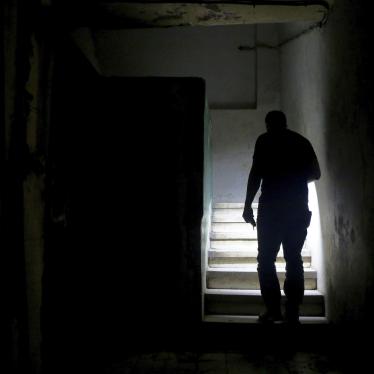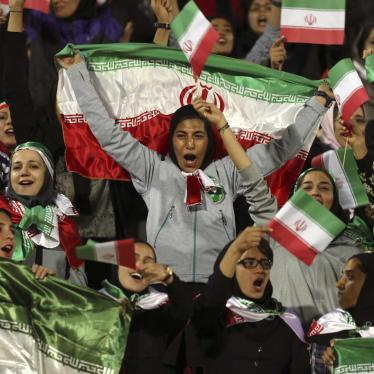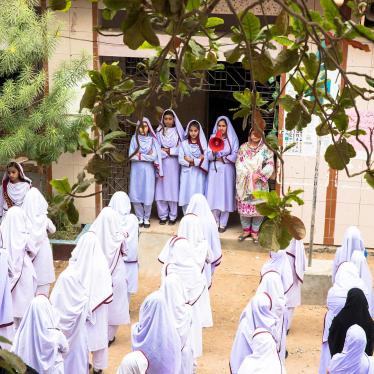The 28th annual United Nations Climate Change Conference (COP28) began on November 30, 2023, in Dubai. The United Arab Emirates’ crackdown on human rights, in particular freedom of expression, assembly, and association, raises grave concerns about how civil society will be able to participate meaningfully at COP28 and push for ambitious language.
As one of the world’s largest oil producers, the UAE also continues to expand fossil fuel operations, casting doubt about its commitment to work with other governments to phase out fossil fuels driving climate change.
In addition to these serious concerns, UAE-based migrant workers face widespread abuses. Migrant workers form 88 percent of the UAE’s population, and the preparation and delivery of COP28 also relied on workers who have faced labor abuses. As Human Rights Watch has recently documented, abuses of UAE-based migrant workers are linked more broadly to climate-related harm.
The UAE’s migrant workers and their communities back home are among those contributing the least to the climate crisis, yet they are often the ones who have the greatest exposure to climate harm and who are struggling the most to deal with the consequences.
The following questions and answers address key questions regarding the failure by UAE, this year’s COP28 host, to protect its migrant workers.
- Are the sites where COP28 is being held in Dubai linked to documented migrant worker abuses?
- Did the UAE implement significant labor reforms in the past several years and how did it ensure that the government had substantially addressed abuses against migrant workers?
- Why do migrant workers continue to face illness and injury from extreme heat in the UAE when there are policies in place that supposedly protect workers?
- UAE and the Gulf region have always had hot temperatures. Why the focus now? And do countries that profit from fossil fuels like the UAE deserve any blame for increasing heat?
- What happens to migrant workers after they experience serious or chronic injuries working in the UAE?
- Why aren’t migrant workers speaking up more in the UAE to criticize all of these abuses, and will they be able to voice their concerns at COP28?
- Haven’t migrant workers traditionally benefitted from remittances they earn while working in the UAE?
- Are there other ways in which migrant labor abuses in the UAE intersect with the climate crisis more broadly?
- What will the role of migrant workers be in the UAE as it adapts to climate change?
- What should the COP28 host do to address widespread abuses against migrant workers?
- Are the sites where COP28 is being held in Dubai linked to documented migrant worker abuses?
Yes. The COP28 sites are themselves linked to serious abuses against migrant workers. Rights organizations have documented that Expo City Dubai, where the talks are being held, was built on labor abuses against workers who built it, including illegal recruitment fees, nonpayment of wages, passport retention, and discrimination. Employers have also exposed workers at COP28 sites to extreme heat by making them work during the summer midday work ban, a government policy that explicitly prohibits outdoor work between mid-June and mid-September from 12:30 p.m. to 3:00 p.m.
Workers have faced these abuses despite the scrutiny brought by international events like COP28 and Expo2020, which are safeguarded by additional labor protection measures such as Expo2020’s Worker Welfare Policy. The situation is worse for migrant workers in sectors or with companies that do not receive the same level of global scrutiny, as documented by Human Rights Watch.
- Did the UAE implement significant labor reforms in the past several years, and how did it ensure that the government had substantially addressed abuses against migrant workers?
The UAE has embarked on several waves of labor reforms, including in 2021. However, the UAE’s labor regulations retain provisions that violate established international labor standards, while severe enforcement gaps further undermine protections.
UAE migrant workers are governed by the restrictive labor governance system known as the kafala (sponsorship) system, which gives employers disproportionate control over migrant workers’ immigration and employment status and thereby their lives.
Human Rights Watch has long documented how the kafala system facilitates abuse and exploitation. It restricts job mobility, enables employers to routinely confiscate workers’ passports, and punishes workers who leave their employers, including to escape abuse, with the risk of deportation and detention. Wage theft and exorbitant recruitment fees are widespread, undermining the benefits of emigrating to the UAE for better earnings.
- Why do migrant workers continue to face illness and injury from extreme heat in the UAE when there are policies in place that supposedly protect workers?
Migrant workers work in sectors like construction, cleaning, agriculture, animal herding, and security that often expose them to the UAE’s extreme heat, yet authorities’ safety regulations are woefully inadequate to protect them.
The UAE’s primary heat protection measure is the aforementioned summer midday work ban. A study in Kuwait, which has a similar climate to the UAE, found an increased risk of occupational injuries associated with extremely hot temperatures despite the ban. Another study found that the highest heat intensity for workers in Saudi Arabia was from 9:00 a.m. to 12:00 p.m., outside the ban hours.
Employers also fail to protect workers from the heat even during workers’ rest hours, as many don’t provide access to cold water and shaded rest areas. Furthermore, heat harm does not occur in isolation. Other common abuses, including crowded living conditions, absence of shaded rest areas, and lack of air-conditioned transportation services during commutes, also affect workers’ ability to rest, rehydrate, and recover from heat exposure.
- UAE and the Gulf region have always had hot temperatures. Why the focus now? And do countries that profit from fossil fuels like the UAE deserve any blame for increasing heat?
As one of the largest oil producers in the world and among the top per capita emitters, the UAE significantly contributes to the climate crisis. Similar to other large oil and gas producers, Emirati fossil fuel operations increase greenhouse gas emissions, contributing to adverse climate change-related human rights impacts. Multiple studies and projections have also indicated that the risks of extreme heat have escalated in the UAE in recent years due to climate change.
The UAE’s state-owned oil company, the Abu Dhabi National Oil Company (ADNOC), recently announced it was expanding all aspects of its operations and increased its production capacity from four million to five million barrels a day, despite the growing scientific consensus that new oil, gas, or coal development will need to be prohibited if governments are to meet global climate targets and protect human rights. The fossil fuel industry provides the majority of the UAE’s government revenue, which it uses in part to invest in an extensive domestic surveillance system to repress dissent at home and to support abusive conflicts abroad.
The Intergovernmental Panel on Climate Change has said that Gulf states’ “extreme wet-bulb temperatures are expected to approach, and possibly exceed, the physiological threshold for human adaptability (35°C)…by the end of the century.” The widely recognized wet-bulb index assesses occupational heat stress by considering factors such as air temperature, humidity, sunlight, and wind. These projections will adversely affect heat-related morbidity and mortality, labor productivity, mental health, and overall health and well-being outcomes.
In some cases, migrant workers engaged in strenuous outdoor work like construction amid inadequate heat protection return home with debilitating chronic conditions.
- What happens to migrant workers after they experience serious or chronic injuries working in the UAE?
Emirati authorities have failed to provide adequate social protection or financial assistance to migrant workers. Instead, the UAE shifts the financial and health burden to overstretched healthcare systems in migrant origin countries when workers are sent home. Migrant workers and their families who face such misfortunes are left to fend for themselves. This situation will worsen in a changing climate.
Heat can exacerbate pre-existing conditions, impair cognitive function, and increase the risk of workplace injuries. Extreme heat can also adversely impact kidney health. Research by Human Rights Watch has shown that workers who experience chronic health harm in the UAE, such as end stage kidney failure, return home with no financial support. With additional medical expenses, inability to work and earn money due to their debilitating health conditions, and intense medical procedures, the lives of migrant workers and their families are turned upside down by kidney disease.
- Why aren’t migrant workers speaking up more in the UAE to criticize all of these abuses, and will they be able to voice their concerns at COP28?
Avenues for UAE-based migrant workers to voice their concerns are severely restricted.
The UAE's laws prohibit workers from collectively organizing, bargaining, or striking, which limits their ability to raise workplace concerns with their employers or pressure government bodies to make structural, worker-centered reforms.
Civil society is also critical to advocate for labor reforms. UAE authorities severely restrict nongovernmental groups and have a zero-tolerance policy for dissent, making it even harder for organizations representing migrant worker interests to work effectively. The government’s opacity around health data also hampers research for evidence-based policymaking, and academics and journalists tend to self-censor to avoid reprisals.
- Haven’t migrant workers traditionally benefitted from remittances they earn while working in the UAE?
Yes, labor migration has been a longstanding livelihood strategy for people in countries like Bangladesh, Pakistan, and Nepal who seek out better earning opportunities. Remittances are critical for families back home to meet vital expenses like food, health, and education. Remittances are equivalent to a quarter of Nepal’s GDP while Pakistan and Bangladesh are among the top 10 remittance recipients globally. According to government statistics from Bangladesh, Pakistan, and Nepal, in 2022, over 100,000 Bangladeshis, 122,000 Nepalis, and 128,000 Pakistanis traveled for employment to the UAE alone.
Widespread abuses like wage theft and illegal recruitment fees, which are endemic in the UAE, eat into migrant workers’ earnings.
Virtually all migrant workers incur high recruitment fee costs to work in the UAE. Due to a lack of access to formal financing facilities, most migrant workers have said they borrowed informally from local moneylenders at annual interest rates as high as 50 percent, sold assets, and depleted family savings to finance recruitment fees. These loans can take months or even years to repay. A significant portion of migrants’ earnings that could be used for food and health are often channeled toward repaying recruitment debts.
Furthermore, paying recruitment fees does not guarantee good jobs. Even though migrant workers primarily come to the UAE for employment, wage abuses are widespread. These include unpaid overtime, arbitrary deductions, and delayed, withheld, unpaid, or inaccurate wages, as Human Rights Watch has extensively documented.
- Are there other ways in which migrant labor abuses in the UAE intersect with the climate crisis more broadly?
Major emitters and oil producers in the UAE are also contributing to climate harm more broadly and beyond its borders. The latest Human Rights Watch research shows that deep-rooted labor abuses in the country contribute to climate harms.
Migrant origin countries like Bangladesh, Pakistan, and Nepal are at the forefront of the climate crisis despite their negligible greenhouse gas emissions of 0.48 percent, 0.98 percent, and 0.10 percent, respectively. The UAE’s migrant workers and their communities back home are often the ones who have the greatest exposure to climate harm and are struggling to deal with the consequences.
Evidence around climate-induced migration shows that it takes place largely within a given country’s borders or to neighboring countries. But climate change is a compounding driver of migration even along established routes such as that from South Asia to the Gulf. In the context of climate change, migration for work can take on even more significance.
However, Human Rights Watch research showed that the abuses migrant workers experience in the UAE restricts their ability to help loved ones back home who were facing life-threatening climate catastrophes.
Migrant workers described the costs of climate-related catastrophes, including their homes being destroyed, livestock killed, agricultural land ruined, and an extensive loss of their livelihoods. Most of the families interviewed said they received limited or no financial support from their governments or other organizations to rebuild their lives. Many families also reported they were unable to rely on remittances from their family members overseas, including from UAE-based migrant workers, because they were struggling to repay recruitment fees.
In many instances, migrant workers who were victims of wage theft or visa fraud instead chose to return home prematurely with outstanding recruitment debts to help their families reeling from devastating floods, as they were not able to send financial support. The cost of such failed migration experiences can be catastrophic.
- What will the role of migrant workers be in the UAE as it adapts to climate change?
The roots of the UAE’s mass recruitment of migrant workers are linked to the explosion of national wealth derived from the fossil fuel industry that has enabled the country’s rapid and ambitious transformation over the last few decades. Migrant workers will also play a critical role as the UAE enters unchartered temperatures and invests in adaptation efforts to deal with climate change.
The jobs that will grow in importance with climate change are also likely to put migrant workers at more risk if the UAE doesn’t take adequate heat protection measures. A migrant worker engaged in air conditioning maintenance and repair, for example, said that “clients demand swift repairs,” leading to 14-hour workdays in the heat. Yet, he did not have insurance and was not paid if he took sick days. Delivery workers, too, have reported working in temperatures so hot that their phones turn off or their gloves melt, but many are not provided with health insurance and pay exorbitant recruitment fees.
Migrant workers are and will continue to be indispensable to maintaining the quality of life in the UAE, all the more so because temperatures on some days already exceeded 50 degrees Celsius (122 degrees Fahrenheit) in 2023. While the UAE's Climate Risk Assessment recognizes that outdoor workers are the most vulnerable to heat-related illnesses, including mortality risks, the UAE has continued to rely solely on the summer midday work ban as its foremost heat protection measure.
COP28 President Sultan Ahmed al-Jaber said he is committed to putting health at the center of climate discussions in announcing the COP28 Health Day. Occupational heat protection in a world of rising temperatures should be central to the climate and health discussions during and after the conference.
- What should the COP28 host do to address widespread abuses against migrant workers?
The Emirati government should strengthen its labor protections for migrant workers, including addressing widespread wage and contract violations. The government should allow trade unions to operate so workers can collectively bargain for better worker protections.
It is more effective to use risk-based standards to protect workers instead of arbitrary calendar-based bans such as the wet-bulb index. Based on its readings and the nature of work being performed, strict work-rest schedules should be maintained with access to shaded areas to prevent body levels rising to dangerous temperatures.
The government should also make available disaggregated and intersectional data that allows epidemiologists to examine the adverse health impacts of climate change on migrant workers that could inform evidence-based policymaking. Workers who face climate harm should be offered a remedy.






